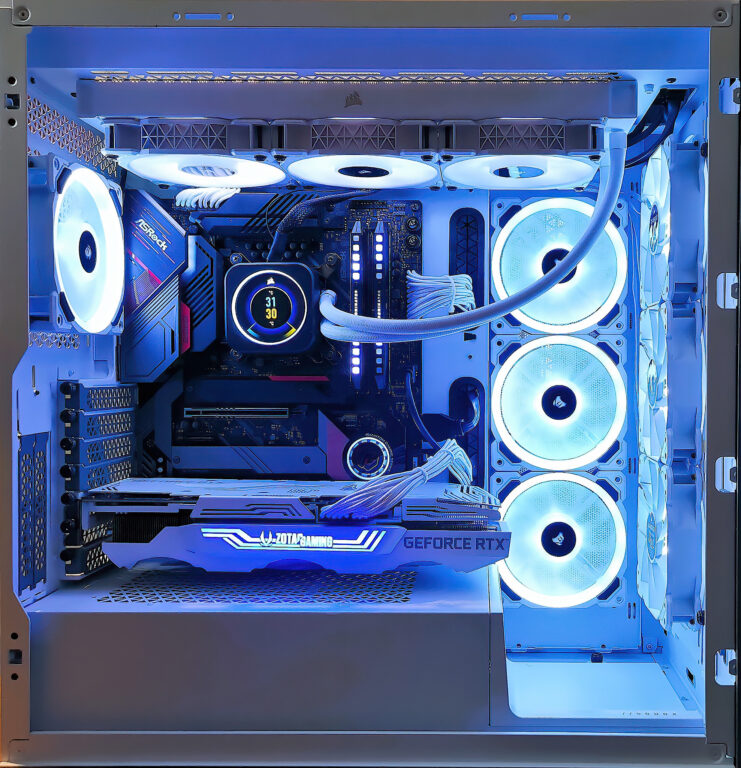TSSDR TEST BENCH AND PROTOCOL
SSD testing at TSSDR differs slightly, depending on whether we are looking at consumer or enterprise storage media. For our Samsung 990 Pro 2TB Gen4 NVMe SSD testing today, our goal is to test in a system that has been optimized with our SSD Optimization Guide.
For this Test Bench, the CPU C-States, Enhanced Intel SpeedStep Technology (EIST) and Intel Speedshift (P-States) have not been disabled. As you will see below, the system is also bumped to 5.1GHz with memory at full speed in its XMP 2 profile.
The components of this Test Bench are detailed below. All hardware is linked for purchase and product sales may be reached by a simple click on the individual item.
INTEL Z690 PCIE 5.0 COMPONENTS
| PC CHASSIS: | Corsair 5000X RGB White Tempered Glass Chassis |
| MOTHERBOARD: | ASRock Z690 Phantom Gaming PG Velocita Gen 5 |
| CPU: | Intel 12th Gen Core i9-12900K |
| CPU COOLER: | Corsair Hydro Series H150i Capellix White |
| POWER SUPPLY: | Corsair RM850x 80Plus White |
| GRAPHICS: | ZOTAC GeForce RTX 3080 Trinity White |
| MEMORY: | Corsair Dominator Platinum RGB DDR5-5200 64GB |
| STORAGE: | Sabrent Rocket 4 Plus Gen 4 4TB NVMe SSD |
| KEYBOARD: | Corsair K70 RGB Mk. 2 SE White Gaming |
| MOUSE: | Corsair M65 RGB Elite FPS Gaming |
| MONITOR: | Samsung 34″ 1440p WQHD Ultrawide Gaming |
BENCHMARK SOFTWARE
The software in use for today’s analysis is typical of many of our reviews and consists of Crystal Disk Info, ATTO Disk Benchmark, Crystal Disk Mark, AS SSD, Anvil’s Storage Utilities, AJA, TxBench, PCMark 10, 3DMark, PassMark Performance Test, Final Fantasy XIV Gaming BenchMark, as well as true data testing. Our selection of software allows each to build on the last and to provide validation to results already obtained.
CRYSTAL DISK INFO VER. 8.17.7 X64
Crystal Disk Info is a great tool for displaying the characteristics and health of storage devices. It displays everything from temperatures, the number of hours the device has been powered, and even to the extent of informing you of the firmware of the device.
Crystal DiskInfo validates that our SSD is running in PCIe 4.0 x4, using the NVMe 2.0 protocol and confirms that it is TRIM capable. 42°C is the hottest we could push this SSD with the heatsink attached. Without the heatsink, surprisingly its highest temperature was 67°C.
ATTO Disk Benchmark is perhaps one of the oldest benchmarks going and is definitely the main staple for manufacturer performance specifications. ATTO uses RAW or compressible data and, for our benchmarks, we use a set length of 256mb and test both the read and write performance of various transfer sizes ranging from 0.5 to 8192kb. Manufacturers prefer this method of testing as it deals with raw (compressible) data rather than random (includes incompressible data) which, although more realistic, results in lower performance results.
ATTO performance hits highs of 6.67 GB/s read and 6.31 GB/s write are as good as it gets. It is also nice to see solid and consistent data throughput progression as sample sizes increased. We think this might just be the best we have seen yet from a Gen 4 M.2 SSD.
 The SSD Review The Worlds Dedicated SSD Education and Review Resource |
The SSD Review The Worlds Dedicated SSD Education and Review Resource | 


For the everyday use of an average user, is there any significant difference between Gen 4 NVMe SSD and Gen 5? Is it worth the expected price difference?
For every day use for the average user any SSD would work. There isn’t an expert in the world that can tell the difference in any SSD during typical everyday use.
That is basically same as asking if it is worth to buy pcie 4 gpu over pcie 5 gpu. It really depends on product and your use case. I would argue that you might see some improvement on games using direct storage, but there are a lot of if:s in that. I would also argue that you see noticeable difference on windows startup time if you go for intel optane 905 which is gen 3 vs any pcie 5 currently on the market. That has like 3x higher 4k read performance. Interface just enabled higher transfer speed, you need something on the other end that can actually use the available bandwidth on the other end. 14GB/s is not really worth it if device can do 100MB/s at 4k file size if that is your primary need. Personally I think pcie 5 SSD is waste of money because most use cases require higher small file reads, which are currently somewhere between 50MB/s and 350MB/s. Most SSD:s are below 100MB/s and optane:s were at bit above 300MB/s. Sadly Intel could not market them properly as they have max transfer speed below 3GB/s, while Samsung 990 is above 7GB/s. It is pretty hard for marketing team to say Intel one would be faster on overall use when most people just look at max transfer speed.
100MB random reads? Thats huge speed. Unbelievable
HI,
I`m getting 4928,6 MB/s read and 5261.61 write RND4K Q32T16 after turning virtualization in bios. You are far faster… What did you optimize in windows??